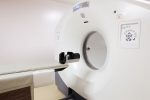Watching My Son Go Into Respiratory Arrest Was Terrifying

Last week, I experienced every parent’s worst nightmare. When my 3-year-old son, Cayden, woke up the other day, I noticed he was coughing a lot more than usual. I prepared to do what we do every morning: remove his BiPAP machine and deliver his breathing treatments, which consist of using a cough assist machine and lots of suctioning with another machine.
But that morning was unlike any other. After removing Cayden’s BiPAP mask, he immediately stopped breathing. His eyes closed and he became unresponsive. I watched as my little boy turned gray and then blue. I panicked.
Most of that morning is a blur, but I remember a few details, such as placing Cayden on the floor and screaming for my younger sister to call 911. Thankfully, my grandma, who is trained in CPR, was planning to visit that day and arrived early. I saw her pull up in her car and remember just screaming for help.
“Cayden isn’t breathing!” I shouted.
Grandma rushed inside and immediately started doing mouth-to-mouth resuscitation while her husband did chest compressions.
First responders were already on their way, and the local police station is located directly behind our apartment complex. My sister ran to summon them, and officers rushed over and started helping us as we waited for the ambulance to arrive.
Cayden finally began breathing again before the first responders arrived. He was in respiratory arrest for only two or three minutes, and his heart didn’t stop during the entire ordeal. But he was airlifted by helicopter to the local children’s hospital, because he was still having trouble breathing.
I rushed to the hospital, too, and when I arrived, Cayden was in bed, awake, alert, and asking for the TV.
The next step was to figure out what had caused his respiratory arrest.
Hospital staff ran several tests in the emergency room and discovered that Cayden has both respiratory syncytial virus (RSV) and rhinovirus/enterovirus. Common this time of year, RSV can land perfectly healthy kids in the hospital, making it even worse for children like Cayden, who have infantile-onset Pompe disease or other chronic illnesses.
What happened with Cayden is that the mucus and secretions caused by the viruses became thick and blocked his airway, causing him to go into respiratory arrest. He was admitted into the pediatric intensive care unit and has remained there since.
Thankfully, Cayden has been functioning well with just his BiPAP machine and hasn’t needed to be intubated like he was during his last illness, when he was battling pneumonia. However, he’s still fighting hard to get through these viruses and will most likely spend a few weeks in the hospital until he is stable enough to return home.
I plan to take a refresher course on CPR before Cayden is discharged from the hospital. Learning CPR is important for everyone, and it can be a crucial factor in situations in which someone stops breathing.
While I’m thankful my son is OK, I can’t forget what happened. I can’t get the image of his lifeless body out of my head. Experiencing someone in respiratory arrest is scary, especially when it’s your own child. But now that it’s happened once, I can be better prepared in case it happens again.
***
Note: Pompe Disease News is strictly a news and information website about the disease. It does not provide medical advice, diagnosis, or treatment. This content is not intended to be a substitute for professional medical advice, diagnosis, or treatment. Always seek the advice of your physician or other qualified health provider with any questions you may have regarding a medical condition. Never disregard professional medical advice or delay in seeking it because of something you have read on this website. The opinions expressed in this column are not those of Pompe Disease News, or its parent company, Bionews, and are intended to spark discussion about issues pertaining to Pompe disease.








John Bach MD
Respiratory arrest is TOTALLY avoidable in Pompe disease if the physicians learn how to use up to continuous noninvasive ventilatory support and Mechanical in-exsufflation. Clinicians of www.breatheNVS.com centers do this. Tracheostomy tubes are never needed for anyone, even infants with severe Pompe disease since they are like infants with SMA type 1 and we manage them without trach tubes or acute respiratory failure as well. Low span BiPAP without MIE is NOT the way to go!